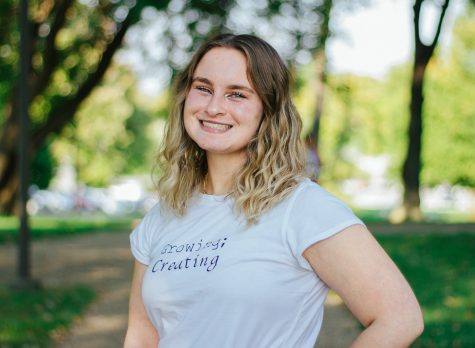Spring semester ends with new beginnings
April 19, 2022
With barely two months until her official start, Dr. Kelly Ryan is more than happy to become interim chancellor of IU Southeast for the next academic year.
“I’m excited about the chancellor role because IU Southeast needs stable leadership and I care deeply about this campus,” said Ryan, who’s currently the executive vice chancellor for academic affairs. “We don’t want this to be a ‘pause and wait’ year. Students, faculty and staff have been suffering and we need to rebuild our community. That is top of mind for me. I feel well-prepared to succeed.”
Ryan didn’t tip her hand when The Horizon asked her whether she wanted the No.1 job permanently or to return to being chief academic officer. “Only time will tell.”
Her career at IUS, however, makes her a leading candidate to replace Chancellor Dr. Ray Wallace, who died last summer. She joined IUS in 2007 as a U.S. history professor teaching courses examining pre-Civil War America and specialized courses in gender and sexuality. She rose to dean of social sciences in 2016 and in July 2020, during the depth of the COVID-19 pandemic, was promoted to lead all IUS academic units.
But Ryan’s current portfolio also includes the Office of the Registrar, the library, the Applied Research and Education Center, Disability Service, First-Year Programs, the 21st Century Scholars Programs, Institute for Learning and Teaching Excellence, International Programs, and the Student Development Center.
She is already optimistic about the fall semester. “Look forward to a reenergized campus. We’re all talking about how to make the moments when you are on campus more lively and engaging. I’m excited for students to dive into their majors, minors and general education topics. I hope students will be willing to stretch their boundaries and try something new and different by attending a club, a campus event, or talking to a person they didn’t know before attending here.”
Current interim Chancellor Dr. Kathryn Girten, who’s retiring June 30, echoes Ryan’s sentiments because many students “are working very hard at juggling complex lives. Many start college right from high school, but many others have done other things in their lives prior to attending college. Classes are small, and students feel like they are known on campus—they are not ‘just a number.’”
To that end, Ryan and other IUS officials are introducing new opportunities such as learning communities in the fall semester that target first-year and transfer students.
These 14 learning opportunities, which offer full academic credit, pair together two different academic courses. An example of a learning community is a coupling of a math course with a business one that is aimed at helping students understand business concepts while simultaneously learning math that can be used in the field. Another learning community pairs an English class with one in psychology. Its goal is that students write about scientific processes of the mind.
In addition to academics, these learning communities can help students build rapport with their peers and with faculty. “They will have a community of learners to help them adjust and learn the ropes, in addition to activities meant to engage them with each other and their professors,” Ryan said.
The learning communities, which blend face-to-face classes with online instruction, span subjects as wide-ranging as world history, neuroscience, diversity and disabilities.
Ryan and others hope that unique academic opportunities such as the learning communities can help attract and retain new undergraduates.
IUS enrollment has been declining since 2011. The campus projects continued erosion in headcount and credit hours for the next two school years. This is against a national backdrop of teens seeming uninterested in attending college. According to IU Studios, the number of teens who considered attending college was 71% in May 2020 but had plummeted to 48% by last September.
Nevertheless, Ryan remains hopeful that IUS enrollment will increase during her year long stint as interim chancellor. The campus is also undertaking an intensive demographics study of the region to determine what is “the best size for IU Southeast,” Ryan said.
As recently as the 2020-21 year, IUS enrollment was 4,000 but it has slid to only 3,500.
“It’s critically important that we get these middle and high school aged students on to our campus to relight that fire around education,” Ryan said. “I’m hopeful our current students also encourage their younger peers to push forward. It breaks my heart to think of dreams being deferred when we know the value of college education transforms individuals and communities. Our region needs more college graduates for better health and economic outcomes.”
Furthermore, Ryan hopes a new dual admission agreement with Ivy Tech Community College “will result in stability” by boosting enrollment numbers and IUS revenue.
Another key goal of Ryan’s as interim chancellor is to develop stronger relationships between the university and the surrounding community. She wants to ensure that IUS students have deeper connections with those in this region so that employers and nonprofit organizations will more likely hire from the student body and alumni.
The national search to replace Wallace has barely begun. Wallace, who had led IUS for seven years, stepped down amid failing health. Girten stepped in as interim chancellor while still serving as chancellor at IU East.
Dr. Susan Sciame-Giesecke, who most recently has been chancellor of IU Kokomo, is chairing the search committee that will sift through permanent IUS chancellor candidates. A new chancellor may be hired by July 1, 2023, said Ryan, who does not expect any installation ceremony for her taking over this summer.



